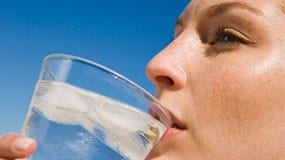At a glance
- Getting enough water every day is important for health and helps the body function normally.
- Plain water consumption varies among demographic and socioeconomic groups.
- CDC and EPA have tools on water safety and how to improve water consumption.

Plain water consumption varies
Getting enough water every day is important for health. Drinking water can prevent dehydration, which may cause unclear thinking, mood change, overheating, constipation, and kidney stones.
Plain water consumption varies by age, race/ethnicity, and socioeconomic status.
During 2015–2018, US children and adolescents drank an average of 23 ounces of plain water daily. US adults drank an average of 44 ounces.
Among US children and adolescents, plain water intake was significantly lower in:
- Younger children.
- Non-Hispanic Black children or Hispanic children, compared to non-Hispanic White children.
- Youth in households with lower incomes.
- Youth whose head of household had less than a high school education.
- Those with underweight or normal weight, compared to those with obesity (Table 1).
Among US adults, plain water intake was significantly lower in:
- Older adults.
- Non-Hispanic Black adults, compared to non-Hispanic White adults.
- Adults with lower income and less education.
- Adults without obesity (Table 2).
Children and adolescents
Table 1. Mean daily plain watera intakes among US children and adolescents 2 to 19, National Health and Nutrition Examination Survey 2015–2018b
* Significantly different from the reference group (P <0.05).a Plain water included plain tap water, water from a drinking fountain, water from a water cooler, bottled water, and spring water.b Data were from a single 24-hour dietary recall and estimates were weighed.c Weight status was based on calculated body mass index (BMI) (kg/m2) from measured weight and height data: underweight/healthy weight (BMI <85th percentile), overweight (BMI 85th to 95th percentile), obesity (BMI ≥95th percentile), in relation to the 2000 CDC growth charts age- and sex-specific percentiles.
Adults
Table 2. Mean daily plain watera intakes among US adults 20 and older, National Health and Nutrition Examination Survey 2015–2018b
GED: General Educational Development.* Significantly different from the reference group (P <0.05).a Plain water included plain tap water, water from a drinking fountain, water from a water cooler, bottled water, and spring water.b Data were from a single 24-hour dietary recall and estimates were weighed.c Weight status was based on calculated body mass index (BMI) (kg/m2): underweight/healthy weight, BMI <25; overweight, BMI 25 to <30; obesity, BMI ≥30.
Tools
CDC toolkits for early care and education settings and schools
- Increasing Access to Drinking Water and Other Healthier Beverages in Early Care and Education Settings
- Increasing Access to Drinking Water in Schools
- Water Access in Schools Microlearning Modules - a guide for schools to help students drink more water during the day.
Nutrition and Obesity Policy Research and Evaluation Network (NOPREN)
Drinking Water Work Group focuses on policies and economic issues regarding free and safe drinking water access.
Environmental Protection Agency (EPA)
Resources
Related pages
- About Water and Healthier Drinks
- Be Smart About Sugar
- Rethink Your Drink
- Foods and Drinks for 6 to 24 Month Olds
Related peer-reviewed publications with CDC authors, 2012 - 2022.
Youth
Associations between household water fluoridation status and plain tap or bottled water consumption.
